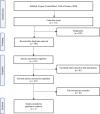Artificial intelligence in estimating fractional flow reserve: a systematic literature review of techniques
- PMID: 37596521
- PMCID: PMC10439535
- DOI: 10.1186/s12872-023-03447-w
Artificial intelligence in estimating fractional flow reserve: a systematic literature review of techniques
Abstract
Background: Fractional Flow Reserve (FFR) is the gold standard for the functional evaluation of coronary arteries, which is effective in selecting patients for revascularization, avoiding unnecessary procedures, and reducing treatment costs. However, its use is limited due to invasiveness, high cost, and complexity. Therefore, the non-invasive estimation of FFR using artificial intelligence (AI) methods is crucial.
Objective: This study aimed to identify the AI techniques used for FFR estimation and to explore the features of the studies that applied AI techniques in FFR estimation.
Methods: The present systematic review was conducted by searching five databases, PubMed, Scopus, Web of Science, IEEE, and Science Direct, based on the search strategy of each database.
Results: Five hundred seventy-three articles were extracted, and by applying the inclusion and exclusion criteria, twenty-five were finally selected for review. The findings revealed that AI methods, including Machine Learning (ML) and Deep Learning (DL), have been used to estimate the FFR.
Conclusion: This study shows that AI methods can be used non-invasively to estimate FFR, which can help physicians diagnose and treat coronary artery occlusion and provide significant clinical performance for patients.
Keywords: Fractional Flow Reverse; Functional evaluation; Machine learning.
© 2023. BioMed Central Ltd., part of Springer Nature.
Conflict of interest statement
The authors declare no competing interests.
Figures
References
-
- Organization WH. Global status report on noncommunicable diseases 2014. World Health Organization; 2014. https://apps.who.int/iris/handle/10665/148114].
-
- Vlachopoulos C, O’Rourke M, Nichols WW. McDonald’s blood flow in arteries: theoreticxperimental and clinical principles. 2011: CRC press. [DOI: 10.1201/b13568].
Publication types
MeSH terms
LinkOut - more resources
Full Text Sources


